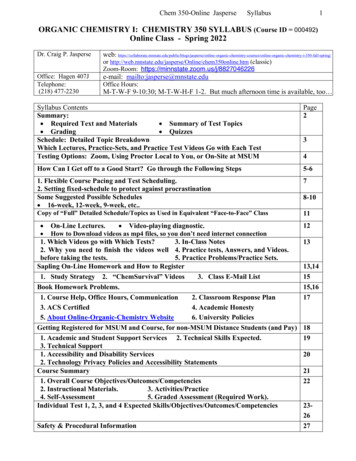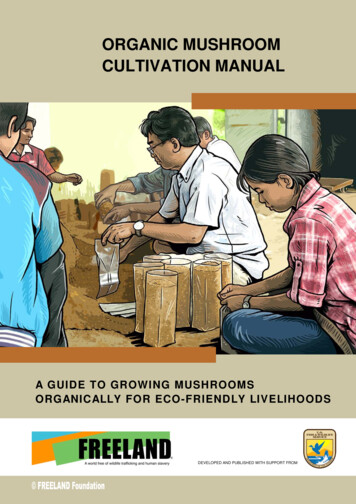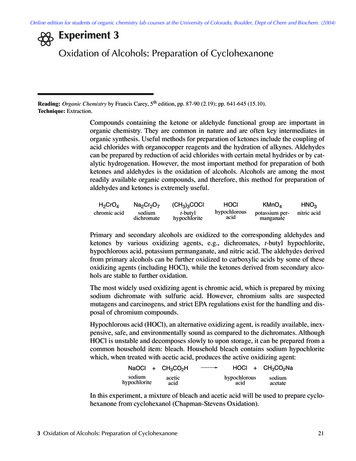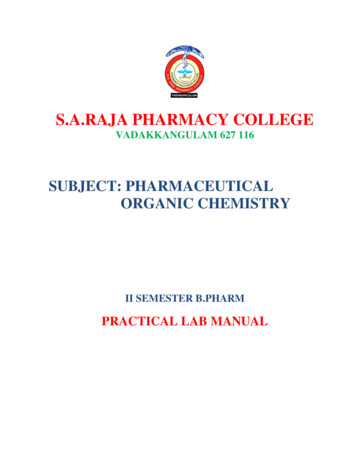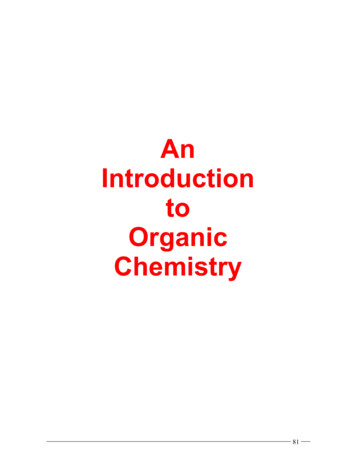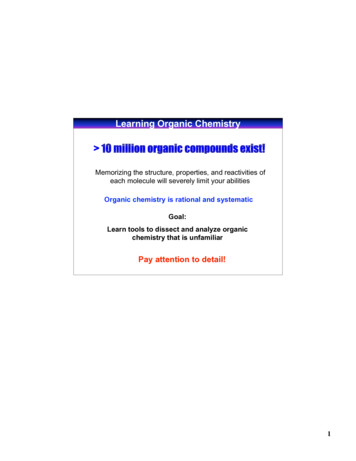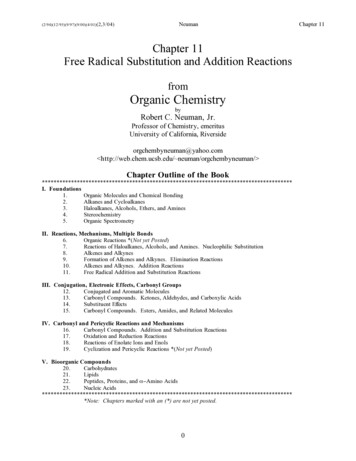
Transcription
er 11Free Radical Substitution and Addition ReactionsfromOrganic ChemistrybyRobert C. Neuman, Jr.Professor of Chemistry, emeritusUniversity of California, Riversideorgchembyneuman@yahoo.com http://web.chem.ucsb.edu/ neuman/orgchembyneuman/ Chapter Outline of the ****************************************I. Foundations1.Organic Molecules and Chemical Bonding2.Alkanes and Cycloalkanes3.Haloalkanes, Alcohols, Ethers, and Amines4.Stereochemistry5.Organic SpectrometryII. Reactions, Mechanisms, Multiple Bonds6.Organic Reactions *(Not yet Posted)7.Reactions of Haloalkanes, Alcohols, and Amines. Nucleophilic Substitution8.Alkenes and Alkynes9.Formation of Alkenes and Alkynes. Elimination Reactions10.Alkenes and Alkynes. Addition Reactions11.Free Radical Addition and Substitution ReactionsIII. Conjugation, Electronic Effects, Carbonyl Groups12.Conjugated and Aromatic Molecules13.Carbonyl Compounds. Ketones, Aldehydes, and Carboxylic Acids14.Substituent Effects15.Carbonyl Compounds. Esters, Amides, and Related MoleculesIV. Carbonyl and Pericyclic Reactions and Mechanisms16.Carbonyl Compounds. Addition and Substitution Reactions17.Oxidation and Reduction Reactions18.Reactions of Enolate Ions and Enols19.Cyclization and Pericyclic Reactions *(Not yet Posted)V. Bioorganic Compounds20.Carbohydrates21.Lipids22.Peptides, Proteins, and α Amino Acids23.Nucleic ******************************************Note: Chapters marked with an (*) are not yet posted.0Chapter 11
er 1111: Free Radical Substitution and Addition Reactions11.1 Free Radicals and Free Radical ReactionsFree Radicals (11.1A)Halogen AtomsAlkoxy RadicalsCarbon Radicals11.2 Halogenation of Alkanes with Br2Bromination of Ethane (11.2A)MechanismInitiation StepPropagation StepsThe CH3-CH2. RadicalRadical Chain Reactions (11.2B)Propagation Steps RepeatMany Chains Occur SimultaneouslyTermination Reactions (11.2C)Combination ReactionsDisproportionation ReactionsPolybromination (11.2D)11.3 Alternate Bromination SitesGeneral Mechanism for Propane Bromination (11.3A)Origins of 1-Bromopropane and 2-Bromopropane (11.3B)Propagation ReactionsTermination ReactionsPolybrominationRelative Yields of 1-Bromopropane and 2-Bromopropane (11.3C)11.4 Relative Reactivity of C-H HydrogensC-H Bond Strengths (11.4A)Bond StrengthsC-H Bond Strength and Alkane StructureRelative Reactivities of C-H'sRadical Stability (11.4B)Relative Stabilities of Alkyl RadicalsOrigin of Radical Stability Order11.5 Alkane Halogenation with Cl2, F2, or I2Chlorination (11.5A)Relative Product Yields in Chlorination and BrominationCl. is More Reactive and Less Selective than Br.Correlation Between Reactivity and SelectivityFluorination and Iodination of Alkanes 11-1311-1411-1411-1711-1811-1811-2111-2311-2311-25
(2/94)(12/95)(9/97)(9/00)(4/01)(2,3/04)Neuman11.6 Radical Additions to AlkenesH-Br Addition (11.6A)H-Br Addition Mechanism (11.6B)PropagationInitiationTerminationH-Br Addition Regiochemistry (11.6C)Radical versus Electrophilic AdditionRadical StabilitySteric EffectsH-Br Addition Stereochemistry (11.6D)H-I, H-Cl, and H-F Additions are Electrophilic (11.6E)Radical Addition of Br2 or Cl2 (11.6F)MechanismCompetitive SubstitutionF2 and I2Chapter 1111-2611-2711-2711-2911-3211-3311-34Appendix A11.7 Alkane Halogenation with Other Reagentst-Butyl Hypohalites (11.7A)Mechanismt-Butyl Hypohalite PreparationN-Bromosuccinimide (11.7B)Overall ReactionMechanism11-3611-3611-37Appendix B11.8 Halogen Atom Reactivity and SelectivityReaction of Methane with X. (11.8A)Structural Changes During ReactionEnergy Changes During ReactionExothermic and Endothermic ReactionsTransition States or Activated Complexes (11.8B)Energy Maximum and Transition StateReaction Rates and Activation EnergyReactivity and Activation EnergiesAn Explanation for Selectivity-Reactivity Correlation (11.8C)Resemblance of Transition States to Reactants and ProductsRadical Character in the Transition StateThe Hammond Postulate211-3811-3911-4111-44
er 1111: Free Radical Substitution and Addition Reactions Free Radicals and Radical Reactions Halogenation of Alkanes with Br2 Alternate Bromination Sites Relative Reactivity of C-H Hydrogens Halogenation with Cl2, F2, or I2 Radical Additions to Alkenes Halogenation with Other Reagents (Appendix A) Halogen Atom Reactivity and Selectivity (Appendix B)11.1 Free Radicals and Free Radical ReactionsMany reactions in earlier chapters have ionic reagents and ionic intermediates. The reactions inthis chapter involve electrically neutral free radicals. These reactions include free radicalhalogenations of alkanes and free radical additions to alkenes.Alkane HalogenationR3C-H X2 R3C-XAlkene AdditionR2C CR2X-Y R2CX-CYR2 H-XSome aspects of these reactions cause them to be more complex than ionic reactions. In order toaddress these details adequately without overwhelming this general presentation, we includesome topics in "Asides" (in small font) in the chapter text, while some are in Appendices at theend of the chapter.Free Radicals (11.1A)Important free radicals that we see in this chapter include halogen atoms (X .), alkoxy radicals(RO .), and carbon free radicals (R3C.).Halogen Atoms. The atoms in column 7A (or 17) of a periodic table are the halogen atoms.Of these, chlorine (Cl) and bromine (Br) atoms are particularly important in the free radicalreactions that we describe here. To clearly contrast them with halide ions (X:-), organic chemistsoften write halogen atoms as X. where the (.) is an unshared electron.3
er 11As with all atoms, each halogen atom has the same number of electrons as it has protons and thatis why it is electrically neutral. In contrast, halide ions (X:-) are negatively charged because eachhas one more electron than it has protons (Table 11.1).Table 11.1. Comparison of Halogen Atoms (X.) and Halide Ions (X:-).X.F.Cl .Br ons9173553electrons10183654We represent halide ions as X:- that shows the reactive unshared electron pair (e.g. see Chapter7). We obtain the symbol X. for the neutral halogen atom by simply removing one electron witha -1 charge (an e-) from X:-.We can also visualize the meaning of X. by picturing its formation from its parent molecularhalogen X2.X2orX-XorX:X X.XThe covalent bond between the two halogen atoms (X-X) is an electron pair (X:X). When thatbond breaks homolytically (undergoes homolysis), each halogen atom retains one of the twoelectrons in that bond.Alternatively we can visualize the formation of the molecular halogens X2 from individualhalogen atoms.X.X X:XorX-XorX2Halogen atoms atoms are highly reactive. They do not exist alone, but in molecules such as X2,H-X, or CH3-X where they are bonded to other atoms. We will see at the end of this sectionwhy organic chemists also refer to halogen atoms as free radicals.Alkoxy Radicals. Another free radical in this chapter is the alkoxy (or alkoxyl) radical (RO.).We saw alkoxide ions (RO:-) in earlier chapters where they were nucleophiles and also strongbases. Alkoxy radicals (RO .) are also highly reactive, but they are electrically neutral.You can see that they are electrically neutral by imagining their formation from alkoxide ions byremoval of one e- [next page].4
Neuman(2/94)(12/95)(9/97)(9/00)(4/01)(2,3/04)RO:- RO.Chapter 11e- This is not a real reaction, but by showing that you can formally make RO. by removing an efrom RO:-, the requirement that we keep charges equal on both sides of the equation shows thatRO. must be electrically neutral.One way that chemists make alkoxy radicals is by decomposing organic peroxides (R-O-O-R).R-O-O-R or R-O:O-Rheat or lightR-O.O-ROrganic peroxides as structurally analogous to hydrogen peroxide (H2O2 H-O-O-H) where theHs are replaced by alkyl groups (R).Carbon Radicals. All organic reactions in this chapter include carbon radicals (R3C.) Werepresent them by showing the uynshared electron (.) to distinguish them from carbocations(R3C ) and carbanions (R3C:-).We can account for their neutral charge (absence of an electrical charge) by imagining theirformation, or reaction, in the hypothtical reactions shown here. e- R3C.carbon radicalR3C. carbon radicale- R3C:carbanionR3C carbocationLet's look at some real reactions that illustrate why a carbon radical is neutral and symbolized asR3C. In Chapter 7, we learned that 3 haloalkanes such as (CH3)3C-I ionize in water.(CH3)3C-Ior(CH3)3C:IH2O (CH3)3C :I-The two electrons in the C-I bond go with the iodide ion causing it to become negative (seeabove) and leaving behind a positively charged carbocation((CH3)3C ).5
er 11In contrast, if we irradiate (CH3)3C-I with light (when it is in a non-polar solvent) we makeiodine atoms (I.) and (CH3)3C. radicals.(CH3)3C-Ior(CH3)3C:Ilight (CH3)3C.IThe I. and (CH3)3C. each retain one electron of the two originally in the C-I bond. Each of thosespecies is electrically neutral because each has an equal number of protons and electrons.Counting Protons and Electrons. You can count up protons and electrons in (CH3)3C . and in I . inorder to verify that each species is electrically neutral. But it is easier to simply recognize that since I . iselectrically neutral (see Table 11.1), (CH3)3C . must also be electrically neutral since they both come fromthe electrically neutral molecule (CH3)3C-I.Why Call Them "Radicals"? We can explain why R3 C . species are called radicals (or free radicals) byunderstanding that the symbol "R" that we have used so often is derived from the word "Radical". Earlychemists referred to the organic parts of molecules as "Radicals" and wrote general examples of thesemolecules such as CH3-OH, or (CH3)3C-I, as R-OH and R-I, respectively.They called the CH3 group in CH3-OH the "methyl radical", and the (CH3)3C group in (CH3)3C-Ithe "t-butyl radical". Using the general formula R-I for (CH3)3C-I, we can symbolize how light causes itto react to form I . as we show here.R-Ilight R.IWhen the R-I bond breaks, R . becomes a "free" radical (R .). Now days, organic chemists reserve the terms"radical" or "free radical" to refer to neutral species such as (CH3)3C . and have extended those terms toinclude neutral species such as RO . and X . .11.2 Halogenation of Alkanes with Br2Free radical halogenation reactions of alkanes and cycloalkanes are substitution reactions in whicha C-H is converted to a C-X.R3C-H X2R3C-X H-XWhile any of the molecular halogens F2, Cl2, Br2, and I2 will halogenate alkanes and cycloalkanes,Br2 or Cl2 are used most often. We will use bromination (X Br) to illustrate alkane6
er 11halogenation. We discuss chorination with Cl2, and possible halogenation using the othermolecular halogens in later sections.Bromination of Ethane (11.2A)We describe the general mechanism of alkane halogenation using bromination of ethane(CH3CH3) to give bromoethane (CH3CH2Br).Figure 11.01CH3-CH3 hνBr2 CH3-CH2-Br H-BrThe Symbol hν . This reaction occurs when we irradiate a mixture of ethane and Br2 , either as gases orin a solvent, with ultraviolet (UV) or visible light. The symbol hν represents UV or visible light energysince the energy (E) of light is proportional to its frequency (ν) ( E h ν )(Chapter 5). We call thisreaction a photochemical reaction because it is initiated by light, but we will also see many radicalreactions that are not photochemical reactions.Mechanism. The overall reaction for photochemical bromination of ethane includes severalseparate steps. We will group the first three of these steps (Figure 11.02 [next page]) into twocategories called initiation and propagation. In order to emphasize that these species areelectrically neutral, we have omitted the traditional " " signs used in chemical reactions.Figure 11.02. Initiation and Propagation Steps for Bromination of Ethane.InitiationBr-Brhν Br.Br(Step1)PropagationCH3-CH3 .BrCH3-CH2. Br-BrCH3-CH2. H-BrCH3-CH2-Br .Br (Step 2)(Step 3)It is important for you to note that the two products of ethane bromination, (CH3-CH2-Br andH-Br) (Figure 11.01), are formed in different reaction steps. H-Br is formed in Step 2 of thisthree step sequence, while CH3-CH2-Br is formed in Step 3 of the same sequence. We will seethat this a characteristic of all chain reactions is that reaction products are formed in differentsteps.7
er 11Initiation Step. In Step 1, light energy breaks the Br-Br bond giving two separate bromineatoms (Br.). As we described in the previous section, the "dot" (.) written with each Br.represents one of the two electrons that originally constituted the chemical bond between thetwo bromine atoms in Br-Br .Br:Brhν Br.Br(Step 1)For the sake of clarity, we do not show the other 3 unshared pairs of electrons on each Br. Wecall this type of bond breaking reaction, where a bonding electron pair divides equally betweenpreviously attached atoms, homolytic scission or homolytic cleavage.Propagation Steps. Each Br. formed in Step 1 (Figure 11.02) has the ability to abstract(remove) an H from ethane. We show this in Step 2 of Figure 11.03a, where Br. removes an Halong with one of the electrons in the C-H bond. H-Br forms in Step 2 and leaves behind areactive molecular fragment (CH3-CH2 .) called an ethyl radical (CH3CH2 .) (Figure 11.03a).Figure 11.03aArrows in Radical Reactions. We show this abstraction of an H by Br . in two different ways in Figure11.03a. In the first reaction, we use curved arrows to portray the way that the electrons in the C-H and CBr bonds move as the C-H bond breaks and the H-Br bond forms. These curved arrows begin at anelectron and point to where the electron ends up in the product of the chemical process.The second reaction in Figure 11.03a is the same process as the first reaction. While we do not showthe individual electrons in the C-H and C-Br bonds, we do use the arrows to represent the movement of theelectrons.It is important to note that these curved arrows shown in Figure 11.03a have only one-half (1/2) of anarrowhead. Organic chemists use such "half-arrowhead" arrows to show the movement of single electrons.8
er 11Curved arrows with full arrowheads show the movement of a pair of electrons (two electrons) in a chemicalprocess as we showed in earlier chaptersThe CH3-CH2. Radical. The ethyl radical (CH3-CH2 .) shown above is a neutral (uncharged)chemical species that forms when Br. removes (abstracts) a neutral H atom from a neutral ethanemolecule. Its geometry might be either planar or pyramidal (tetrahedral) (Figure 11.03b).Figure 11.03bIf it is pyramidal, the C. atom is sp3 hybridized (Chapter 1) and the single unpaired electron is inan sp3 orbital. If it is planar, the C. atom is sp2 hybridized (Chapter 1) and the single unpairedelectron is in a 2p atomic orbital perpendicular to the plane containing the C-H and C-C bonds.Experimental results and calculations indicate that alkyl radicals generally prefer to be planar.The ethyl radical. like most alkyl radicals, is very reactive because of its unshared electron.Alkyl radicals rapidly react with other molecules or other radicals that provide another electronto form a chemical bond. During ethane bromination, the ethyl radical reacts primarily withmolecular bromine (Br2) by abstracting a Br to form a C-Br bond (Step 3, Figure 11.02). Weprovide more details for that reaction in Figure 11.04 using the curved "half-arrowhead" arrowsthat are sometimes used to show the movement of electrons in radical reactions.Figure 11.049
er 11A Comment About Radicals. If you have already studied Chapter 5 (Organic Spectrometry), then youshould note that this ethyl radical, formed as an intermediate in bromination of ethane, is identical to ethylradicals formed in the mass spectral fragmentation reactions of alkanes such as butane, pentane, hexane, etc.that we described in that chapter.Radical Chain Reactions (11.2B)Free radical alkane halogenation reactions are chain reactions.Propagation Steps Repeat. The Br. that forms in Step 3 (see below) reacts with anotherethane molecule in Step 2 (see below) and the resulting ethyl radical reacts with a new Br2 inStep 3 to once again form Br.PropagationCH3-CH3 .BrCH3-CH2. Br-BrCH3-CH2. H-BrCH3-CH2-Br .Br (Step 2)(Step 3)This cycle of "Step 2 followed by Step 3" repeats many times giving high yields of the productCH3CH2 Br from Step 3, and the product HBr from Step 2 (Figure 11.05).Figure 11.05Since free radicals are intermediates in each of Steps 2 and 3, and because these two steps seemto form a continuous reaction "chain", we call the bromination of ethane a radical chainreaction.We call Steps 2 and 3 propagation reactions because in each of them, one radical speciesgenerates another radical keeping the "chain" alive. For example, Br. reacts with ethane to giveCH3-CH2 . in Step 2, while CH3-CH2 . reacts with Br2 to regenerate Br. in Step 3.Many Chains Occur Simultaneously. We call homolytic decomposition of Br2 into Br.atoms (Step 1, Figure 11.02) an initiation reaction because it gives the radicals that start the"chains". When we irradiate the reaction mixture, many Br2 molecules simultaneously undergohomolytic scission into Br. atoms (although this represents only a small fraction of the Br210
er 11molecules that are present). Br2 continues to decompose by Step 1 as long as the reactionmixture is irradiated with light. As a result, many Br. are produced at the same time, so many"chains" of Steps 2 and 3 start at the same time in the reaction flask.Termination Reactions (11.2C)Since there are many radicals present at the same time, these radicals formed in initiation or inpropagation reactions (Figure 11.02) sometimes react with each other instead of reacting in thepropagation steps. These reactions between two radicals lead to combination ordisproportionation reactions that we collectively call termination reactions.Combination Reactions. Br. atoms and CH3CH2 . radicals can combine with each other inthe 3 ways shown in Figure 11.06.Figure 11.06. Termination Combination Reactions in Bromination of Ethane.Br. .BrCH3-CH2. .BrCH3-CH2. .CH2-CH3 Br-BrCH3-CH2-Br(Step 4)(Step 5) CH3-CH2-CH2-CH3(Step 6)If two Br. radicals encounter each other they can combine to form Br2 (Step 4). Similarly, if aBr. encounters a CH3CH2 . they can also combine (Step 5). Finally, two ethyl radicals(CH3CH2 .) sometimes encounter each other and combine to give butane.Comment About Butane. We do not show butane as a reaction product in the overall reaction for ethanebromination (Figure 11.01) because this combination reaction occurs so infrequently compared to thepropagation reactions that butane is only formed in very low yield. We comment on this further in an"Aside" at the end of this section.Disproportionation Reactions. Besides undergoing combination reactions, two radicalssometimes react by disproportionation as we show for CH3-CH2. and Br. radicals in Figure11.07.Figure 11.07. Termination Disproportionation Reactions in Bromination of Ethane.Br.CH3-CH2.CH3-CH2.CH3-CH2. Br-H CH3-CH3CH2 CH2CH2 CH2(Step 5a)(Step 6a)In these disproportionation reactions, a radical (Br. or CH3CH2.) abstracts a hydrogen atom from11
er 11an ethyl radical (CH3CH2 .) as we show in Figure 11.08 using curved arrows.Figure 11.08In Step 5a, the Br. that abstracts H becomes H-Br while the CH3-CH2. that loses the H becomesethene (CH2 CH2). In Step 6a, an ethyl radical (CH3-CH2 .) abstracts an H from another CH3CH2. giving ethane and ethene .Termination Reaction Products. The combination reactions involving Br . (Step 4 and Step 5) arechemically "invisible" because Step 4 forms Br2 that is one of the starting materials, while Step 5 leads tobromoethane (CH3 CH2 Br) that is one of the reaction products. But this is not the case for some of theother termination products.For example, we did not show the termination reaction products from Steps 5a and 6a (ethene, ethane,and butane) in the overall reaction for bromination of ethane (Figure 11.01). Ethane is the startingmaterial, so its formation in a termination reaction is invisible. However, butane and ethene are undesiredside products. We ignore them because their yields are very low compared to that of the desired organicproduct bromoethane (CH3 CH2 Br). The propagation steps (Steps 2 and 3 in Figure 11.02) leading tobromoethane occur many times before Step 5a and/or 6a occurs.Because two radicals that react with each other can no longer propagate chains (Steps 2 and 3), allthree of these combination reactions are called termination reactions. Eachtermination reaction stopstwo chains.Polybromination (11.2D)A disadvantage of radical halogenation reactions, such as bromination of ethane, is that thedesired product (in this case CH3CH2Br) may be further brominated. The 5 H's that remain onbromoethane (CH3CH2Br) are reactive toward Br. like those on ethane. As a result, it is difficultto prevent the bromination of bromoethane to give dibromoethanes (Figure 11.09)[next page].12
er 11Figure 11.09These dibromoethanes in turn may undergo further bromination to tribromoethanes. Ultimatelythe products can also include tetrabromoethanes, pentabromoethane, or hexabromoethane.Minimizing Polybromination. While we cannot prevent the formation of these polybromoalkanes, wecan minimize them by using a large excess of the alkane reactant compared to Br2 . We can also minimizepolybromination by permitting the monobromination reaction to proceed only partly to completion.Each of these strategies causes the unreacted alkane to have a higher concentration than that of thebromoalkane product. As a result, bromine atoms in the reaction mixture encounter and react withunbrominated ethane molecules much more frequently than with bromoethane molecules that are present inmuch lower concentration.11.3 Alternate Bromination SitesAll 6 H's on ethane (CH3CH3) are chemically equivalent so abstraction of any of them gives onlybromoethane. However, this is not true for most other alkanes. For example, propane has twodifferent types of H's and its bromination simultaneously gives both 1-bromo-propane and 2bromopropane as reaction products.CH3-CH2-CH2Br H-Br1-bromopropanehνCH3-CH2-CH3 Br2 andCH3-CHBr-CH32-bromopropane13 H-Br
er 11General Mechanism for Propane Bromination (11.3A)The reaction mechanisms for formation of 1-bromopropane and 2-bromopropane frombromination of propane are analogous to that for bromination of ethane (Figure 11.10).Figure 11.10. General Mechanism for Formation of MonobromopropaneProducts from Bromination of Propane.InitiationhνBr2 Br.Br propyl. H-Brbromopropane .Br(Step 2)(Step 3) Br2(Step 4).Br (Step 5)propyl. .propyl combination anddisproportionationcombination inationBr.propyl.Br2.Br.Br(Step 1)(Step 6)We will not distinguish between the two types of H's in propane, nor the different pathways toformation of 1- or 2-bromopropane, in this figure so that you can see its similarity to ethanebromination (Figures 11.1 and 11.6). This mechanism has initiation, propagation and terminationsteps like those for ethane bromination.The initiation step (Step 1) is identical to that for ethane bromination Figure 11.02. In the firstpropagation step (Step 2), a Br. from Step 1 reacts with a propane molecule to give a propylradical and H-Br The propyl radical reacts with Br2 in the second propagation step (Step 3) togive a molecule of bromopropane and Br. That Br. reacts with another molecule of propane byrepeating Step 2. Termination steps include combination of two Br. to give Br2, reaction of a Br.and a propyl radical by combination or disproportionation, and combination ordisproportionation of two propyl radicals.Origins of 1-Bromopropane and 2-Bromopropane (11.3B)1-bromopropane and 2-bromopropane form at the same time in this reaction because each Br. hasthe choice to abstract two different types of H atoms from propane.14
er 11Propagation Reactions. Abstraction of H from either CH3 group of propane gives a 1propyl radical, while abstraction of H from the CH2 group gives a 1-methylethyl radical(commonly called the 2-propyl or isopropyl radical) (Figure 11.11).Figure 11.11When the 1-propyl radical reacts with Br2, the product is1-bromopropane, while reaction of the1-methylethyl radical with Br2 leads to 2-bromopropane (Figure 11.12).Figure 11.12The Br. resulting from either of these reactions abstracts an H from propane to form either a 1propyl radical, or a 1-methylethyl radical, that subsequently react with Br2 to repeat thissequence.Termination Reactions. Since -propyl radicals and 1-methylethyl radicals are present togetherin this reaction mixture, there are many different combination and disproportionation reactionsthat are possible. In each case, two radicals react to give non-radical products that terminate theirradical chains.15
er 11The Various Termination Reactions. The terminationcombination reactions (Step 5 in Figure 11.10)give both 1-bromopropane as and 2-bromopropane.Figure 11.13In the disproportionation reactions (Step 5 in Figure 11.10) Br . abstracts an H from either of the twodifferent alkyl radicals to give propene and H-Br. These reactions are analogous to the disproportionationreaction between Br . and ethyl radical that gives ethene (Step 5A, Figure 11.07).Termination reactions between propyl radicals (Step 6 in Figure 11.10) include several combinationand disproportionation reactions analogous to those for ethyl radicals in Figures 11.06 and 11.07.Figure 11.1416
er 11The combination products of Step 6 are hexane (CH3(CH2)4CH3), 2-methylpentane ((CH3)2CHCH2 CH2 CH3) or 2,3-dimethylbutane ((CH3)2CH-CH(CH3)2). The disproportionation reactions giveonly propene (CH3 CH CH2) and propane (CH3 CH2 CH3). As was the case with ethane bromination, theyields of these side products are much lower than those of the desired products 1-bromopropane and 2bromopropane.Polybromination. The products 1-bromopropane and 2-bromopropane can be furtherbrominated to give a variety of polybromopropanes as we described in Section 11.2 forpolybromination of ethane. We can minimize formation of polybrominated compounds using thesame strategies that we described for ethane bromination.Relative Yields of 1-Bromopropane and 2-Bromopropane (11.3C)The yields of 1-bromopropane and 2-bromopropane are not the same. At 150 , the relative yieldof 1-bromopropane is 8% of the monobrominated products, while 2-bromopropane has a 92%relative yield. This result is surprising since if all H's on propane were equally reactive to Br.,the relative yield of1-bromopropane should be 75%, and that of 2-bromopropane should be 25%.Figure 11.15This is because 6 of the 8 H's (75% of the H's) on propane are on CH3 groups whose abstractionleads to 1-bromopropane. In contrast, only 2 of the 8 H's (25% of the H's) are on the CH2 groupwhose abstraction leads to 2-bromopropane.The much greater yield of 2-bromopropane (92%) compared to 1-bromopropane (8%) occursbecause an H on the CH2 group of propane is more reactive than an H on either of the CH3groups. We describe this reactivity difference, and its origin, in the following section.17
er 1111.4 Relative Reactivity of C-H HydrogensThe relative product yields in free radical alkane halogenation reactions depend not only on thenumbers of H's available for abstraction, but also on the relative strengths of their C-H bonds.C-H Bond Strengths (11.4A)The H's on the CH2 group of propane are more reactive than those on the CH3 groups because ofdifferences in the relative bond strengths of these C-H bonds.Bond Strengths. C-H bond strengths are the amount of energy required to break theindicated C-H bond to give the corresponding carbon radical and H.CH3-CH2-CH2 420 kJ/mol CH3-CH2-CH2andH. 1-propylH.CH3-CH-CH3 413 kJ/mol CH3-CH-CH3andH. 1-methylethylHWhile these specific reactions do not occur during bromination of propane, the lower bondstrength of the CH2 bonds compared to the CH3 bonds, tells us that it is easier for Br. to abstractan H from CH2 than from CH3. We see this direct correlation between C-H bond strength andC-H reactivity in bromination of alkanes when we examine product distributions in alkanebromination.C-H Bond Strength and Alkane Structure. Alkane C-H bond strengths (Table 11.2)generally decrease in the order CH3-H RCH2-H R2CH-H R3C-H (Table 11.2 [next page]).While there is only one example for R3C-H, the two examples for R2CH-H, and three examplesfor RCH2-H, show that the same trends apply to different alkyl groups (R).Table 11.2. Approximate Bond Strengths for Various C-H Bonds in AlkanesC-H Bond TypeCompoundCH3-H (methyl)RCH2-H (1 )CH3-HCH3 CH2-HCH3 CH2 CH2-H(CH3)3CCH2-H(CH3)2CH-H(CH3 CH2)(CH3)CH-H(CH3)3C-HR2 CH-H (2 )R3 C-H (3 )Bond Strength (kJ/mol)18438423420420413411404
er 11When one alkyl group (R) replaces an H on CH4, we call the 3 remaining H's on RCH3 primary(1 ) H's. Similarly, the 2 H's on R2
Organic peroxides as structurally analogous to hydrogen peroxide (H2O2 H-O-O-H) where the Hs are replaced by alkyl groups (R). Carbon Radicals. All organic reactions in this chapter include carbon radicals (R3C.) We represent them by showing the uynshared electron (.) to distingu


